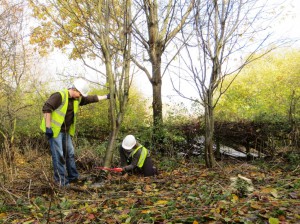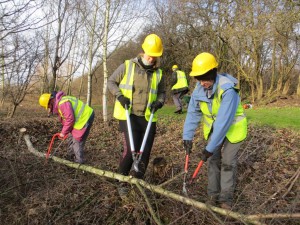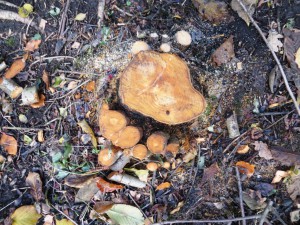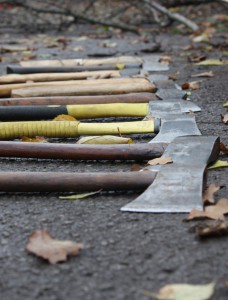
Its been a busy winter in the woods at Skelton Grange – with coppicing and tree felling taking place, and lots of eager volunteers. The woodlands that were planted 20 years ago are now providing a whole range of opportunities; the are a valuable habitat for wildlife (although as the trees get bigger we seem to have more and more pesky grey squirrels), a wild space for the many visitors to the centre, a shelter from the sun and the rain, and also a sustainable source of materials for use on site and in craft activities.
Its a really exciting time to be involved; balancing the management of the woodland with selected harvesting of materials – and the range of things they can be used for – spoons, beanholes, hedging stakes, stools, christmas crafts, as well as firewood for our bushcraft and Forest School sessions.
One of the main things that you notice when working with new volunteers is that cutting down trees is usually seem as been a ‘non-environmental’ thing to do – its associated in many people’s minds with clearing land and deforestation. However – we are removing trees in one of two ways – either thinning out the densely planted woodlands so that the remaining trees have space to grow into a fuller form, or coppicing areas of trees – which will then grow back. We are cutting down trees to improve the woodland, not to degrade it. In fact by coppicing trees you can actually prolong their lives, bringing fresh, strong new life – as well as harvesting timber from them. Opening up areas of the woodland in this way also opens up opportunties for different forms of wildlife, by bringing light and open space to the woodland floor. But there’s also a management challenge in carrying out the work – it can feel very strange cutting down trees that you’ve watched grow for the last decade!
We’ve been fortunate this year to have been able to run a series of woodland management days as part of our Skelton Grange Wild Area project with funding from Biffa Award – volunteers have learnt how to fell trees safely, process the timber and leave the stumps to give them the best chance of growing and regenerating. This work is mostly done using traditional hand tools – bowsaws, billhooks and loppers, which can be hard work but very satisfying! Now we have various piles of timber set aside, with just a creative mind needed to decide what could be made from them!
We’re finishing our woodland management work with a another traditional craft, with some hedgelaying sessions over the next couple of weeks. A chance to wield a billhook, and create a dense barrier hedge that is also an excellent habitat for wildlife. So if you want to get involved before the end of the season then get in touch!



